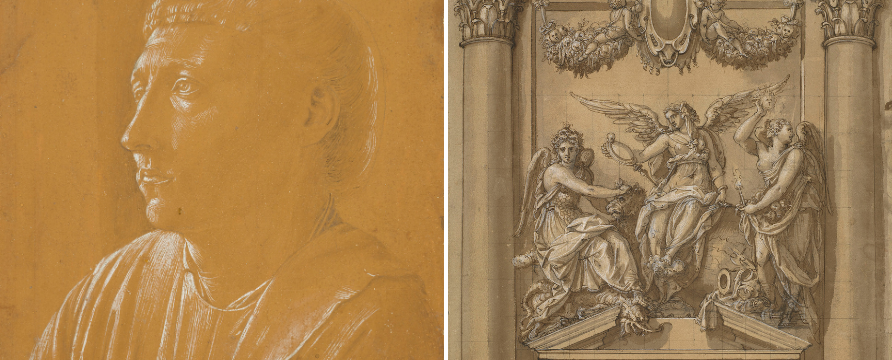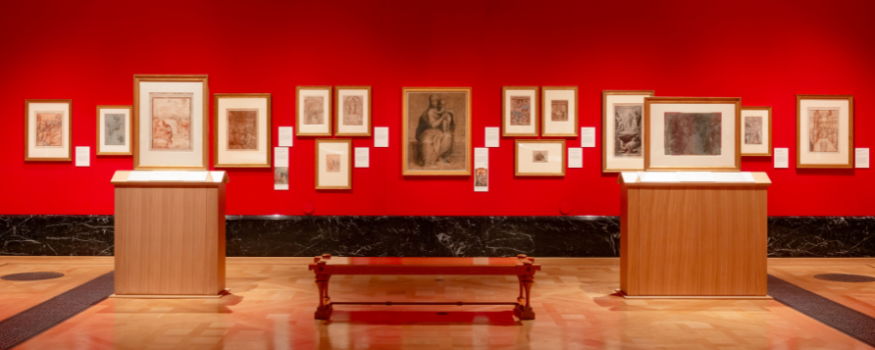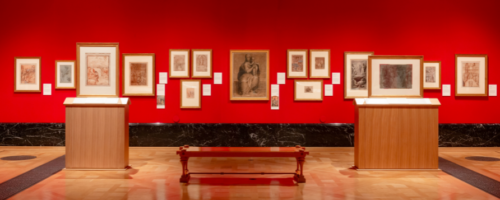The Royal Collection Trust has announced that over 80 works of Italian Renaissance artists are on display at The King’s Gallery, Buckingham Palace, until 9 March 2025. This exhibition presents the most extensive collection of drawings from the period ever shown in the UK.
Drawing the Italian Renaissance combines 160 drawings by artists, including Leonardo da Vinci, Michelangelo, Raphael and Titian, and lesser-known names, to demonstrate how drawing flourished between 1450 and 1600. Over 30 works are on display for the first time, and a further 12 have never been shown in the UK.
Martin Clayton, Curator of Drawing the Italian Renaissance said, “The Royal Collection holds an astonishing array of Italian Renaissance drawings, and brought together on this scale, they show just how dynamic and exciting drawing became during this period. Viewing these drawings up close gives us an intimate insight into the artist’s mind and creative process, almost as if we are looking over their shoulder and watching them work. These drawings cannot be on permanent display for conservation reasons, so this is a once-in-a-generation chance to see such a breadth of Italian Renaissance masterpieces together in one exhibition.”
During the Italian Renaissance, as paper became more accessible and new materials were introduced, drawing became central to every stage of the artist’s process. Visitors can see drawings created as preparatory works for a wide range of projects, from paintings, architecture and sculpture to metalwork, tapestry and costume – as well as rare examples of drawings created as finished works of art in their own right.
The exhibition highlights works by lesser-known artists who created some of the Italian Renaissance’s most remarkable drawings. Among these is a dynamic study of a young man from around 1590, recently reattributed to Pietro Faccini. This piece, displayed for the first time in over 50 years since its last showing in Rome, reveals the Bolognese artist’s style through its strong jawline, fleshy lips, and restrained use of oiled charcoal. Faccini’s reputation faded over time, largely due to the limited number of his surviving paintings.

Another less familiar name will be that of the Carracci family – brothers Annibale and Agostino and their cousin Ludovico – who founded an informal academy that insisted on the importance of drawing from life. They worked in various genres as they prepared compositions for paintings, including altarpieces and friezes – such as Ludovico Carracci’s sketch of A seated male nude (c.1590) – and fictional landscapes. On display for the first time is early work by Annibale Carracci, A landscape with a lobster (c.1590), showing the sea creature with a nutcracker, possibly depicting a proverb or joke about the lobster not managing to crack a nut with its own claws.
Visitors can also discover the draughtsmanship of artists primarily known for working in other mediums. In A Prophet or Philosopher (c.1557), Paolo Veronese experiments with the twisting shape of a body, sketching multiple versions of the same bearded figure. Executed in black-and-white chalk on blue paper, the drawing is thought to be a study for Veronese’s decorations in the Library of St. Mark, Venice.
Bernadino Campi’s large-scale The Virgin and Child (c.1570–80) is also on display for the first time. As a cartoon used to transfer a final design onto a painting’s surface, the drawing was executed on poor-quality paper and never intended to be kept – let alone displayed. In preparation for the exhibition, this rare survival underwent approximately 120 hours of conservation treatment by Royal Collection Trust conservators to remove a degraded canvas backing and support sections where the paper had become as delicate as lace.
Reflecting the continued importance of drawing for artists and creatives today, The King’s Gallery’s will host its first Artists in Residence programme, organised in partnership with the Royal Drawing School. The artists Jesse Ajilore, Joshua Pell and Sara Lee Roberts – whose work ranges from computer game design to urban landscapes – will be drawing in the gallery on Mondays, Thursdays and Fridays throughout the exhibition’s run, bringing a fresh perspective to the Renaissance masterpieces on display. Visitors to the exhibition will also be encouraged to try their hand at drawing, with paper and pencils available in the gallery. They will hear from one of the artists, Jesse Ajilore, on the complimentary multimedia guide.
Click here to find out more about Drawing the Italian Renaissance exhibition.










